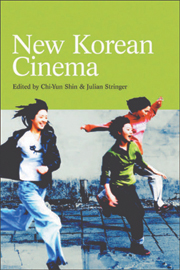Book contents
- Frontmatter
- Contents
- Notes on the Contributors
- List of Illustrations
- Introduction
- Part I Forging a New Cinema
- Part II Generic Transformations
- 6 Putting Korean Cinema in its Place: Genre Classifications and the Contexts of Reception
- 7 Horror as Critique in Tell Me Something and Sympathy for Mr.Vengeance
- 8 Two of a Kind: Gender and Friendship in Friend and Take Care of My Cat
- 9 ‘Just Because’: Comedy, Melodrama and Youth Violence in Attack the Gas Station
- 10 All at Sea? National History and Historiology in Soul's Protest and Phantom, the Submarine
- Part III Social Change and Civil Society
- Glossary of Key Terms
- Bibliography of Works on Korean Cinema
- Websites
- Index
6 - Putting Korean Cinema in its Place: Genre Classifications and the Contexts of Reception
from Part II - Generic Transformations
Published online by Cambridge University Press: 05 August 2013
- Frontmatter
- Contents
- Notes on the Contributors
- List of Illustrations
- Introduction
- Part I Forging a New Cinema
- Part II Generic Transformations
- 6 Putting Korean Cinema in its Place: Genre Classifications and the Contexts of Reception
- 7 Horror as Critique in Tell Me Something and Sympathy for Mr.Vengeance
- 8 Two of a Kind: Gender and Friendship in Friend and Take Care of My Cat
- 9 ‘Just Because’: Comedy, Melodrama and Youth Violence in Attack the Gas Station
- 10 All at Sea? National History and Historiology in Soul's Protest and Phantom, the Submarine
- Part III Social Change and Civil Society
- Glossary of Key Terms
- Bibliography of Works on Korean Cinema
- Websites
- Index
Summary
Mark Jancovich has demonstrated that struggles over genre classification reveal much about how social identities are constructed through the use of cultural distinctions. As he explains, ‘genre definitions are produced more by the ways in which films are understood by those who produce, mediate and consume them, than they are by the internal properties of the films themselves’ (Jancovich 2001: 33–4). More than this, genres cannot
simply be defined by the expectations of ‘the audience’, because the audience is not a coherent body with a consistent set of expectations. Different sections of the audience can have violently opposed expectations. Not only can the generic status of an individual film change over time, it can also be the object of intense struggles at a particular moment. A film which, for some, may seem obviously to belong to one genre may, for others, clearly belong to another genre altogether.
(Jancovich 2001: 35)These observations – which suggest that genre classification is a process to be observed, rather than a fixed destination to be arrived at – are of particular relevance in the case of the simultaneous reception at multiple exhibition sites of New Korean Cinema. South Korea's emerging national film industry is revealing itself to be open to struggles over its meaning and status at home and abroad. Questions of genre have a crucial role to play in this regard.
- Type
- Chapter
- Information
- New Korean Cinema , pp. 95 - 105Publisher: Edinburgh University PressPrint publication year: 2005



